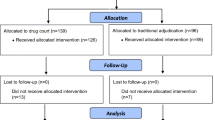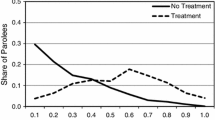Abstract
The determinants of recidivism are increasingly becoming the focus of public concern. This study explores the relative effect of type of intervention, offender characteristics, and type of incident offense on time to a petition to revoke probation and time to a probation revocation. Our analysis of intervention effects includes both parametric and nonparametric estimation procedures. Estimating five distributional forms of survival and a proportional hazard model for each measure of recidivism, the analysis indicates no difference in the effect of a program of drug monitoring and treatment, compared to drug monitoring only, for either of the two measures of recidivism. In addition, findings indicate that younger offenders and African American offenders have a shorter time to a petition to revoke probation. We also found a reduced time to failure for a probation revocation for African American offenders and offenders with a prior arrest record. Our findings offer empirical support for a reconsideration of the type of intervention effective in deterring offenders while on probation.
Similar content being viewed by others
References
Allison, P. D. (1984).Event History Analysis, Sage, Beverly Hills, CA.
Britt, C. L., III, Gottfredson, M. R., and Goldkamp, J. S. (1992). Drug testing and pretrial misconduct: An experiment on the specific deterrent effects of drug monitoring defendants on pretrial release.J. Res. Crime Delinq. 29: 62–78.
Carver, J. A. (1986). Drugs and crime: Controlling use and risk through testing. NIJ Reports SNI 199 (Sept./Oct.).
Chung, C., Schmidt, P., and Witte, A. (1991). Survival analysis: A survey.J. Quant. Criminol. 7: 59–98.
Cox, D. R. (1972). Regression models and life tables.J. Roy. Stat. Soc. Ser. B 34: 187–220.
Elandt-Johnson, R. C., and Johnson, N. L. (1980).Survival Models and Data Analysis, John Wiley & Sons, New York.
Goldkamp, J. M., Gottfredson, M., and Weiland, D. (1990). Pretrial drug testing and defendent risk.J. Crim. Law Criminol. 81: 585–652.
Harrell, F. E., Jr. (1986).The PHGLM procedure. SUGI Supplemental Library User's Guide, SAS Institute, Inc., Cary, NC.
Kalbfleisch, J. D., and Prentice, R. L. (1980).The Statistical Analysis of Failure Time Data, John Wiley & Sons, New York.
Kaplan, E. L., and Meier, P. (1985). Nonparametric estimates from incomplete observations.J. Am. Stat. Assoc. 53: 457–481.
Land, K. C., McCall, P. L., and Williams, J. R. (1990). Something that works in juvenile justice.Eval. Rev. 14: 574–606.
Lattimore, P. K., Witte, A. D., and Baker, J. R. (1990). Experimental assessment of the effect of vocational training on youthful property offenders.Eval. Rev. 14: 115–133.
Lee, E. (1980).Statistical Methods for Survival Data Analysis, Wadsworth, Belmont, CA.
MacKenzie, D. L. (1991). The parole performance of offenders released from shock incarceration (boot camp prisons): A survival time analysis.J. Quant. Criminol. 7: 213–238.
Maguire, K. E., Flanagan, T. J., and Thornberry, T. P. (1988). Prison labor and recidivism.J. Quant. Criminol. 4: 3–18.
Maltz, M. (1984).Recidivism, Academic Press, New York.
Rauma, D., and Berk, R. A. (1987). Remuneration and recidivism: The long-term impact of unemployment compensation on ex-offenders.J. Quant. Criminol. 3: 3–27.
Rhodes, W. (1986). A survival model with dependent competing events and right-hand censoring: Probation and parole as an illustration.J. Quant. Criminol. 2: 113–137.
SAS Institute, Inc. (1985).SAS User's Guide: Statistic Version 5 Edition, SAS Institute, Cary, NC.
Schmidt, P., and Witte, A. D. (1980). Evaluating correctional programs.Eval. Rev. 4: 585- 600.
Schmidt, P., and Witte, A. D. (1988).Predicting Recidivism Using Survival Models, Springer-Verlag, New York.
Schmidt, P., and Witte, A. D. (1989). Predicting criminal recidivism using “split populationℍ survival time models.J. Econometrics 40: 141–159.
Smith, D. A., Wish, E. D., and Jarjoura, G. R. (1989). Drug use and pretrial misconduct in New York City.J. Quant. Criminol. 5: 101–126.
Speckart, G., Anglin, M. D., and Deschenes, E. P. (1989). Modeling the longitudinal impact of legal sanctions on narcotics use and property crime.J. Quant. Criminol. 5: 33–56.
Stewart, K., Gruenewald, P. J., and Parker, R. N. (1992). Assessing legal change: Recidivism and administrative per se laws.J. Quant. Criminol. 8: 375–394.
Visher, C. A., and Linster, R. L. (1990). A survival model of pretrial failure.J. Quant. Criminol. 6: 153–184.
Visher, C. A., Lattimore, P. K., and Linster, R. L. (1991). Predicting the recidivism of serious youthful offenders using survival models.Criminology 29: 329–366.
Walker, S. (1989).Sense and Nonsense About Crime: A Policy Guide, Brooks/Cole, Pacific Grove, CA.
Wheeler, G. R., and Hissong, R. V. (1988). A survival time analysis of criminal sanctions for misdemeanor offenders.Eval. Rev. 12: 510–527.
Witte, A. D., and Schmidt, P. (1977). An analysis of recidivism, using the truncated lognormal distribution,Appl. Stat. 26: 302–311.
Yezer, A., Trost, R., and Toborg, M. (1989). Assessment of Pretrial Testing in the District of Columbia: The Efficacy of Using Urine Test Results in Risk Classification of Arrestees. Report submitted to the National Institute of Justice, Washington, DC.
Author information
Authors and Affiliations
Rights and permissions
About this article
Cite this article
Hepburn, J.R., Albonetti, C.A. Recidivism among drug offenders: A survival analysis of the effects of offender characteristics, type of offense, and two types of intervention. J Quant Criminol 10, 159–179 (1994). https://doi.org/10.1007/BF02221157
Issue Date:
DOI: https://doi.org/10.1007/BF02221157




